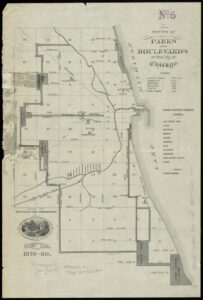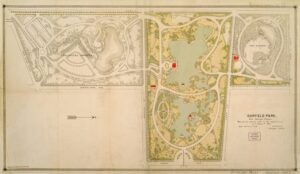
by Ron Becker, Class of 2019
If Chicago is determined that it had lived up to its motto, Urbs in Horto, during its first century, much of the credit is due to the early landscape architects who designed the city’s major parks. Frederick Law Olmstead and Calvert Vaux designed Washington and Jackson Parks and Midway Pleasance, connecting them beginning in 1869. Lincoln Park was originally designed by Swain Nelson in 1865 and later enlarged by Ossian Cole Simonds in 1903. Beginning in the 1920s and following the expansion of its contours by lakefill, Edward H. Bennett was designing Grant Park, essentially as we recognize it today, in accordance with the Chicago Plan of 1909 that he co-authored with Daniel H. Burnham. Outstanding landscape architects Alfred Caldwell and Jens Jensen later added their stamp to the parks.
However, little mention is ever made of the architects of the West Park system, William Le Baron Jenney and Oscar Felicien Dubuis. The West Park system consists of Humboldt, Garfield, and Douglas Parks, the latter renamed Douglass Park in 2020. It may be that Willian Le Baron Jenney’s reputation as a landscape architect has been overshadowed by his innovative work in the skeletal construction that has earned him fame as “Father of the Skyscraper.” He is also known for the veritable who’s who of Chicago architects that passed through his practice including Daniel H. Burnham, Louis Sullivan, William Holabird, Martin Roche, Irving Pond, Normand Smith Patton, William Mundie, and Elmer C. Jensen.
Jenney began his engineering studies at Harvard; dissatisfied with the curriculum, he enrolled at the École Centrale des Arts et Manufactures (École Centrale Paris) in 1853 to study architecture and civil engineering. This was the approximate time Baron Haussmann began the redevelopment of Paris. Jenney would have encountered the plans of Jean-Charles Adolphe Alphand who Haussman brought on to see the development of parks in Paris. Jenney likely encountered some of the parks designed by Paul de Lavenne, comte de Choulot. These two landscape artists were designing in the more natural style of English country gardens. The formal Jardin à la Française, exemplified by Andre le Nôtre at Versailles, was falling out of favor.
On this side of the Atlantic, Jenney might have been influenced by Andrew Jackson Downing, the foremost American landscape architect of his day. On a trip to England, Downing met Calvert Vaux. He hired Vaux, eventually raising him to full partnership. After Downing’s tragic death, Vaux would form a partnership with Frederick Law Olmstead to win the commission to design New York’s Central Park. Jenney met Olmstead during the Civil War, at Vicksburg, where Jenney was building fortifications and Olmstead was investigating troop conditions as Secretary of the U.S. Sanitary Commission. They formed a years-long friendship.

Jenney’s plan for the West Parks was a series of grand parks connected by broad boulevards, an idea that decades later would be ensconced in the 1909 Plan of Chicago. Jenney’s engineering skills would be required to transform the nearly flat, marshy lands near Chicago’s then western border into luscious park lands.
 Another major Jenney effort occurred in Riverside, Illinois. Olmstead and Vaux prepared the overall plan for Riverside but resigned the commission due to a lack of funds. Jenney, then a resident of Riverside, completed the work as a partner in the firm Jenney, Schermerhorn and Bogart.
Another major Jenney effort occurred in Riverside, Illinois. Olmstead and Vaux prepared the overall plan for Riverside but resigned the commission due to a lack of funds. Jenney, then a resident of Riverside, completed the work as a partner in the firm Jenney, Schermerhorn and Bogart.

When Graceland Cemetery was undergoing an expansion, William Le Baron Jenney was commissioned to lay out the grounds. His plan encompassed three lakes, including Lake Willowmere. He constructed the infrastructure, including sewers that enabled the expansion. His plans were completed by O. C. Simonds, who trained under Jenney.
Jenney was the landscape architect for other cemeteries, parks, and grounds of manorial mansions. When he resigned as superintendent of the West Parks in 1877, his associate, Oscar F. Dubuis, was appointed to succeed him. Dubuis would serve in that position until 1891 when he was ousted in a patronage squabble. He worked for a year at Lincoln Park before working with Frederick Law Olmstead on the grounds for the Columbian Exposition.

 Oscar Felicien Dubuis was born in Canton Vaud in Switzerland. He was educated at the Polytechnic Institute at Winterthur, Switzerland, followed by an architectural apprenticeship. In 1870 he immigrated to Chicago and joined Jenney’s firm. Late in 1893 he was recruited by the City of Peoria, Illinois, to be the first director of their park system. In Peoria he designed a series of grand parks in a naturalist style. These included Glen Oak Park, Laura Bradley Park, and South Park.
Oscar Felicien Dubuis was born in Canton Vaud in Switzerland. He was educated at the Polytechnic Institute at Winterthur, Switzerland, followed by an architectural apprenticeship. In 1870 he immigrated to Chicago and joined Jenney’s firm. Late in 1893 he was recruited by the City of Peoria, Illinois, to be the first director of their park system. In Peoria he designed a series of grand parks in a naturalist style. These included Glen Oak Park, Laura Bradley Park, and South Park.

He also designed Grand View Park on a bluff overlooking the Illinois River. President Theodore Roosevelt, during a 1910 visit, described Grand View Drive as “the world’s most beautiful drive.” Oscar Dubuis died in Peoria in 1906, before Grand View Drive was completed. His obituary stated: “Mr. Dubuis was a remarkable man in his versatility. He was at once an artist, an architect, an engineer, a landscape gardener and a botanist, and was proficient in all.”
William Le Baron Jenney died in Los Angeles, California in 1907.
CLICK HERE for more stories on The Bridge.




Great article! Thanks Ron!
Well-researched, illustrated and interesting, as always.
Ron, I appreciate your research and thank you for including the visuals!
Thanks for your research and article, Ron, and your introduction to Oscar Felicien Dubuis! Your article inspired me to learn more about his many contributions to Peoria’s park system.
Wonderful article! I am from Peoria and Oscar Dubuis also developed the plan for Grandview Drive which is listed on the National Register of Historic Places. It is said that on a visit in 1910, Theodore Roosevelt proclaimed it to be the “World’s Most Beautiful Drive.”